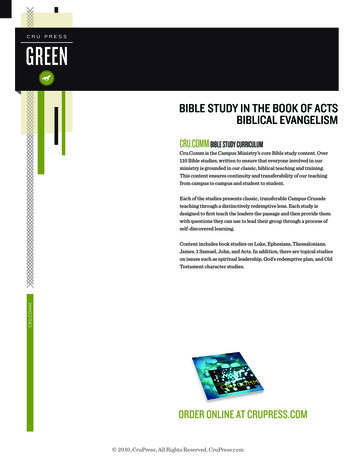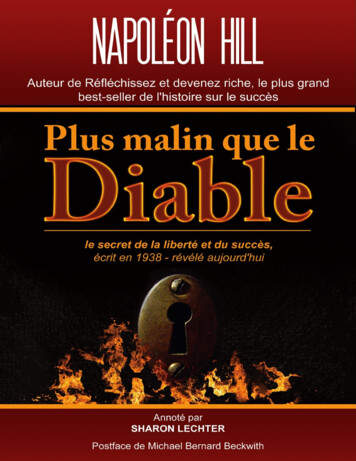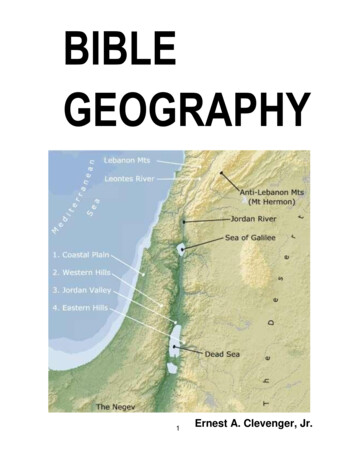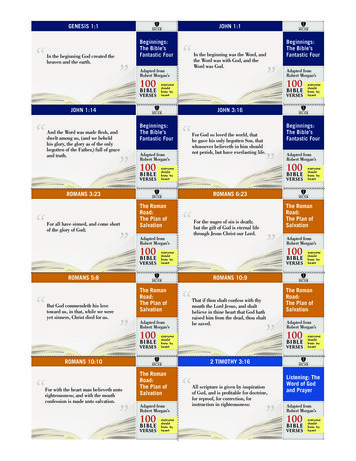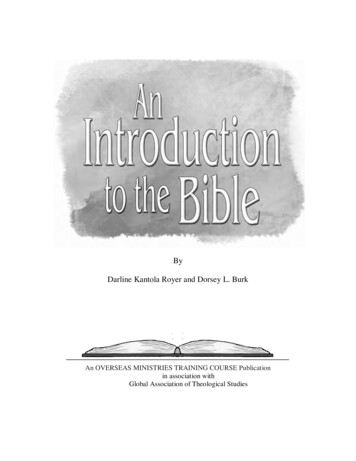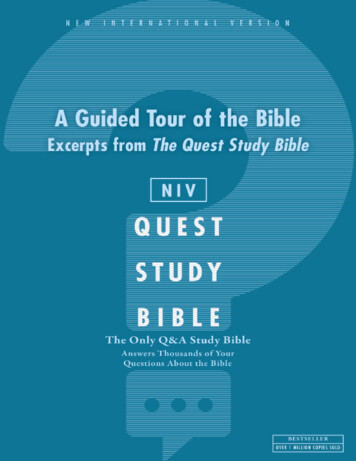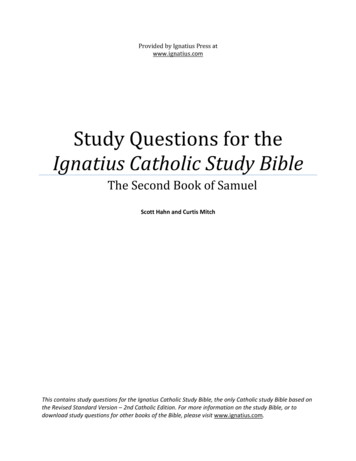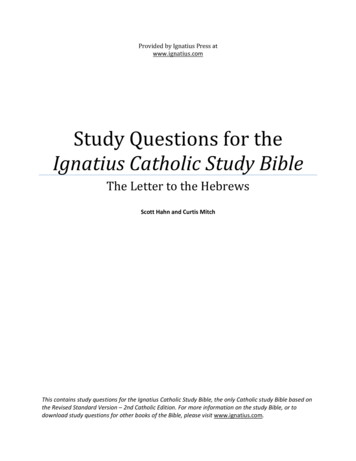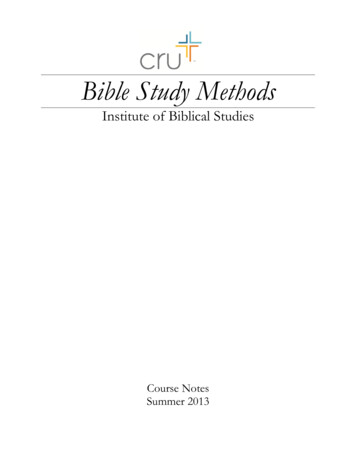
Transcription
Bible Study MethodsInstitute of Biblical StudiesCourse NotesSummer 2013
Institute of Biblical Studies / New Staff TrainingSummer 2013Bible Study Methodspage 1Bible Study MethodsOh how I love your law!It is my meditation all the day.Your commandment makes mewiser than my enemies,for it is ever with me.I have more understanding than all my teachers,for your testimonies are my meditation.I understand more than the aged,for I keep your precepts.I hold back my feet from every evil way,in order to keep your word.I do not turn aside from your rules,for you have taught me.How sweet are your words to my taste,sweeter than honey to my mouth!Through your precepts I get understanding;therefore I hate every false wayPsalm 119:97-104, ESVOne cannot help but be struck with the Psalmist’s love for the Scriptures that radiates from theseverses. The Psalmist, of course, was not merely in love with the Bible (a kind of “bibliolatry”) buthe was in love with the God whose Bible he read. For the Psalmist seeking God and pursuing hisWord were not two activities to be neatly separated. They were one and the same. Notice theparallelism between “seeking God” (line one) and “hiding the word in his heart” (line three) in anearlier portion of Psalm 119:With my whole heart I seek you;let me not wander from your commandments!I have stored up your word in my heart,that I might not sin against you.Ps. 119:10-11, ESVThe Psalmist sought God through the Scriptures. The Word of God was not merely information tobe amassed but the means through which the Psalmist sought and responded to God. The Psalmistreminds us how vital the Scriptures are to a growing and vibrant relationship with God.
Institute of Biblical Studies / New Staff TrainingSummer 2013Bible Study Methodspage 2The Scriptures are also vital to the ministry to which God has called us.In both his letters to Timothy Paul urges this young leader to root his life and ministry in theScriptures. In I Timothy 4:6-16 Paul outlines almost ten qualities that should characterize Timothy’slife as a “good servant of Christ Jesus.” The very first quality Paul mentions is being a leader who is“constantly nourished on the words of the faith” (v. 6). The fact that this phrase is in the presenttense implies an ongoing activity of seeking nourishment.Paul reminds Timothy that just as his body needs physical nourishment, so too his soul needsspiritual nourishment. In doing this he is calling Timothy to far more than a daily “quiet time.” Heis saying to Timothy, “If you want to be an effective leader you got to become a self-feeder.” This isno less true for you and I. We too must become self-feeders.Have you ever been in a conversation with a student who was deeply struggling over some issue andfound yourself wishing that you knew the Bible better so you could more effectively help themthrough it? Have you ever listened to someone give a message from Scripture and thought, “I wishI could communicate the Bible’s message more clearly”? Have you ever wished that you were ableto better lead others from the Word?The foundation of growth in each of these areas is becoming a self-feeder. Becoming a self-feeder isone of the most important habits you can cultivate. This course is designed to be the first steptoward helping you become a person who feeds themselves from the Scriptures.Course DescriptionUsing an educationally sound, workshop-style approach, Bible Study Methods is designed to introduceyou to a process for studying the Bible and give you a chance to improve your skills, all under thewatchful eye of a skilled mentor. You will be exposed to the classic principles of interpretation, andthen you will turn theory into practice by applying the principles as you study the book ofEphesians.This course will cover the entire process of Bible study, from motivation, to interpretive principles,through skills and tools, all the way to communicating the text to others. After a lecture each day,your trained workshop coach will teach you skills and guide you through the use of tools to help yousee and savor the glory of Christ in the Scriptures.This course represents the first in a sequence of three courses you will complete in studying andcommunicating the Bible. Following Bible Study Methods you will complete Biblical Interpretation andBiblical Communication. In Biblical Interpretation you will learn how to interpret and apply the diverseliterary forms in the Bible including narrative, prophesy, poetry, law, and gospel. In BiblicalCommunication you will you will learn how to communicate the Bible’s message in a Christ-centeredand life-changing way.
Institute of Biblical Studies / New Staff TrainingSummer 2013Bible Study Methodspage 3Course Objectives to be introduced to tools that can help you better understand Scripture and apply it to yourlife to discover why it is important to relate every passage to the redemptive story-line of theBible to experience the gospel as you discover how Scripture exposes your brokenness/rebellion(fallen condition) and points you to find true life in Christ (redemptive solution) to learn how to discern the “fallen condition” and “redemptive solution” in a passage ofScripture to learn how to point people to Christ through small groups by asking good questions withthe launch/explore/apply template to be better equipped for ministry by applying interpretive principles to your future reading,study and teaching from epistles to become aware of how our cultural perspectives might blinds us to aspects of the gospel to prepare you for Biblical Interpretation and Biblical CommunicationCourse Values1. Christ-centered Focus: The deepest longing of the human heart is to know and enjoy theglory of God. As John Piper notes, “We were made to know and treasure the glory of Godabove all things; and when we trade that treasure for images, everything is disordered. Thesun of God’s glory was made to shine at the center of the solar system of our soul. Andwhen it does, all the planets of our life are held in their proper orbit. But when the sun isdisplaced, everything flies apart. The healing of the soul begins by restoring the glory ofGod to its flaming, all-attracting place at the center” (Seeing and Savoring Christ, p. 21). Ourultimate goal in this course is not that you would master all the skills we present but that youwould cultivate a deeper hunger to “see and savor” the glory of Jesus Christ revealed in theScriptures.2. Integrated Learning Environment: This is not a traditional lecture course. You willlearn not merely by “hearing” but also by “doing,” not merely by observing but also byexperiencing. We are convinced that the best way to learn about studying the Scriptures isnot by reading books about how to study the Bible but by studying the Bible under thewatchful eye of a coach.3. Excellence - We assume that you are here because you want to be here and we are hopefulthat you will catch a love for the Scriptures and a desire to know truth that will motivate youfrom the inside to please the Lord with your work. Ultimately it is Him that you are serving(Col. 3:23).A note on academic integrity and plagiarism: Plagiarism is similar to stealing another’sideas or thoughts and, therefore, unacceptable for Cru staff. Please refrain from copying orparaphrasing bible studies you read or find online. The penalty for plagiarism will be determined by
Institute of Biblical Studies / New Staff TrainingSummer 2013Bible Study Methodspage 4IBS and may include automatic failure for the course. Ask your coach if you have questionsconcerning plagiarism.4. Collegiality - This is not a competition. We encourage you to help each other, and ourdesire is to help you. NOTE: Collegiality does not mean that you may work together with other studentson your worksheets in such a way that two people turn in identical work.5. Development - We realize that everyone comes into class with a wide variety of experiencesregarding formal training in Bible Study. Some of you may have graduated from a Biblecollege where you covered a number of these skills. Others may have had no previousexperience in formal Bible study. Wherever you happen to be as you enter this class, ourheart is that you would take a “next step” in your development.Required TextsUltimate Road Trip. Orlando: Cru Press, 2008, updated.Piper, John. Seeing and Savoring Jesus Christ. Wheaton: Crossway, 2001Roberts, Vaughan. God’s Big Picture: Tracing the Story-line of the Bible. Downers Grove:Intervarsity: 2002. (Minor updating done in 2012)Snodgrass, Klyne. The NIV Application Commentary: Ephesians. Grand Rapids: Zondervan,1996.Recommended TextsArnold, Clinton. Ephesians, Zondervan Exegetical Commentary of the New Testament.Grand Rapids: Zondervan, 2010.Bruce, F. F. Ephesians, New International Commentary on the New Testament. GrandRapids: Eerdmans, 1984.Hoehner, Harold W. Ephesians: An Exegetical Commentary. Baker Exegetical Commentary onthe New Testament. Grand Rapids, Baker, 2003.Lincoln, Andrew. Ephesians, Word Biblical Commentary, Vol. 42. Dallas: Word, 1990.O’Brien, Peter T. The Letter to the Ephesians, Pillar New Testament Commentary. GrandRapids: Eerdmans, 1999.Thielman, Frank. Ephesians. Baker Exegetical Commentary. Grand Rapids: Baker, 2010.Course Requirements1. Thoughtful Reading: You are expected to read the assigned texts/articles carefully andthoughtfully.2. Vital Participation: Discussion is a vital part of the learning process for this class. Youwill be expected to contribute ideas and opinions based on your reading and comprehensionof the course material.
Institute of Biblical Studies / New Staff TrainingSummer 2013Bible Study Methodspage 53. Textual Worksheets: You will be expected to complete eight worksheets that will enableyou to practice the core skills we will present in the class. These will be turned in to yourcoach for review and evaluation.4. Bible Study Project: Your final assignment in the course will be to develop a small groupBible study, based on the passage you have studied, which you can use in your ministrysetting. All the worksheets will contribute towards this project.Class ScheduleTopicDateChrist-CenteredBible StudyThurs., June 13ContextFri., June 14Analyzing Structure(no lecture)Mon, June 17Observing DetailsTues., June 18Interpretive SkillsWed, June 19Creating aTextual Outline(no lecture)Thurs., June 20Finding Our Place inGod’s StoryFri., June 21Christ-centeredApplicationMon., June 24Leading Christcentered Small GroupsTheologicalDevelopment andMinistryAssignments for that eveningWorksheet: #1 (Book Summary)“Hearing the Music of the Gospel”Worksheet: #2 (Context)NIV Application Commentary (NIVAC), 17-31.Seeing and Savoring, C1Worksheet: #3 (Structural Layout)Seeing and Savoring, C3Worksheet: #4 (Observation)Seeing and Savoring, C5Article: “Asking Good Questions”Worksheet: #5 (Interprsetation)NIVAC, 123-139;African Bible Commentary,The Ultimate Road Trip, 99-111 (chapter 8)Seeing and Savoring, C10Worksheet: #6: (Textual Outline)Seeing and Savoring, C9*God’s Big Picture, IntroductionWorksheet: #7: (Theological Analysis)God’s Big Picture, C7NIVAC, 139-147.The Ultimate Road Trip, 36, 52-57Seeing and Savoring, C12Article: “Bridging the Gap between the World ”Worksheet: #8: (Application)NIVAC, 147-156.Article: “Understanding Scripture’s Fallen-Cond ”Article: “Asking Christ-Centered Questions thatTarget the Heart”Tues., June 25Bible Study ProjectSeeing and Savoring, C13Wed., June 26Turn in Bible Study Project
Institute of Biblical Studies / New Staff TrainingSummer 2013Bible Study Methodspage 6Course GradeYour course grade will be based on the following:8 Textual WorksheetsBible Study Project80% (80 points)20% (20 points)100%To determine your course grade complete the following:1. Total the points from your 8 worksheets:(80 points possible)2. Write in the score from your project:(20 points possible)3. Add #1 and #2 together4. Determine your gradeGrading Scale:94-10092-9390-9184-8982-83AAB BB-80-8174-7972-7365-710-65C CCDFCoachesBible Study Methods is not a class for passive learning. As in any “methods” class, the desiredoutcomes will not be accomplished by just taking an exam that demonstrates a knowledge of thetheory of Bible study. We will talk about theory. We will teach sound exegesis and hermeneutics.But many of the skills and principles can only be learned by working in the text, trying out thedifferent tools, and deliberately applying the principles taught. The coaching workshops areessential to the learning that takes place in this class. As you learn the principles of Bible Study, youwill be able to work your way through the process under the helpful and watchful eye of a mentor.Your mentor will give you constructive feedback and be available to answer your questions. Youwill get personal attention that would be impossible in a lecture style format. This class is beingtaught by a team of qualified people rather than by one individual. The coaches have been chosenbecause of their knowledge of the Scriptures, their love for Christ, and their ability in a particularaspect of Bible study. They come from various ministries and responsibilities, but each of themshares a desire to blend academic integrity with passionate ministry.
Institute of Biblical Studies / New Staff TrainingSummer 2013Bible Study Methodspage 7Select BibliographyIntroductionVirkler, Henry A., and Karelynne Gerber Ayayo. Hermeneutics (Grand Rapids: Baker Academic,2007).Hendricks, Howard. Living By the Book (Chicago: Moody, 1991).Kostenberber, Andreas and Richard Patterson. Invitation to Bliblcal Interpretation (Grand Rapids:Kregel Academic, 2011).Authorship - EphesiansArnold, C.E. “Ephesians, Letter to the” Dictionary of Paul and His Letters. Downers Grove: IVP, 1993,pp. 238-249.Carson, D.A., Moo, D., Morris, L. An Introduction to the New Testament (Grand Rapids: Zondervan.1992), 367-371. 480-486.Hoehner, Harold W. Ephesians: An Exegetical Commentary. Baker Exegetical Commentary on the NewTestament (Grand Rapids, Baker, 2003), 1-61.Lincoln, Andrew. Ephesians. Word biblical Commentary, Vol. 42 (Dallas: Word Books, 1990), lixlxxiii.Carson, D. A. “Pseudonymity and Pseudepigraphy,” in Dictionary of New Testament Background, ed.Stanley E. Porter and Craig A. Evans. Downers Grove: IVP, 2000, 857-64.Meade, David. Pseudonymity and Canon (Grand Rapids: Eerdmans, 1987), 1-16.O’Brien, Peter T. The Letter to the Ephesians, Pillar New Testament Commentary (Grand Rapids:Eerdmans, 1999), 4-46.Historical ContextCarson, D. A., Moo, D., Morris, L. An Introduction to the New Testament (Grand Rapids: Zondervan.1992), 305-316 486-490.Virkler, Henry A., and Karelynne Gerber Ayayo. “Historical-Cultural and Contextual Analysis”Hermeneutics (Grand Rapids: Baker Academic, 2007), 79-96.Osborne, Grant. The Hermeneutical Spiral (Downers Grove: IVP Academic, 2006) 158-80.Hawthorne, Gerald, et. al., eds., Dictionary of Paul and His Letters (Downers Grove: IVP, 1993).ObservationHendricks, Howard. Living By the Book (Chicago: Moody, 1991), 141-192.GenreRyken, Leland. How to Read the Bible as Literature. Grand Rapids: Zondervan, 1984Alter, Robert. The Art of Biblical Narrative. Basic Books: Harper Collins, 1981Fee, Gordon and Douglass Stuart, How to Read the Bible for All It’s Worth (Grand Rapids: Zondervan,1981, 1993), 45-77.Goldsworthy, Graeme, Preaching the Whole Bible as Christian Scripture: The Application of Biblical Theologyto Expository Preaching (Grand Rapids: Eerdmans, 2000).
Institute of Biblical Studies / New Staff TrainingSummer 2013Bible Study Methodspage 8The Importance of StructureArnold, Jeffrey. Discovering the Bible for Yourself (Downers Grove: IVP, 1993), 71-80.Osborne, Grant. The Hermeneutical Spiral (Downers Grove: IVP Academic, 2006), 57-81.InterpretationBaker, David. “Interpreting Texts in the Context of the Whole Bible” Themelios 5.2 (1980) pp. 21-25Hirsch, E.D. Validity in Interpretation. (New Haven: Yale Univ. Press, 1967) .Johnson, Elliott. “Author’s Intention and Biblical Interpretation” Hermeneutics, Inerrancy and the Bible.Radmacher, E., Preus, R., Eds. (Grand Rapids: Zondervan, 1984)Kostenberger, Andreas and Richard Patterson. Biblical Interpretation: Exploring the Hermeneutical Triad ofHistory, Literature and Theology. (Grand Rapids: Kregel, 2011).Osborne, Grant. The Hermeneutical Spiral (Downers Grove: IVP Academic, 2006).Padilla, Rene. “The Interpreted Word: Reflections on Contextual Hermeneutics” Themelios 7.1 (1981)pp. 18-23Ramm, Bernard. Protestant Biblical Interpretation. W. A. Wilde Company, 1950 pp. 78-96Robert, Vaughan. God’s Big Picture: Tracing the Story-line of the Bible. Downers Grove: Intervarsity: 2002Schreiner, Thomas. Interpreting Pauline Epistles. (Grand Rapids: Baker Academic, 2011, 2nd ed.)ApplicationDoriani, Daniel, Putting the Truth to Work: The Theory and Practice of Biblical Application (Phillipsburg:Presbyterian and Reformed Pub., 2001).Biblical CommunicationThe Ultimate Road Trip (Orlando: Cru Press, 2008, updated).Chapel, Brian, Christ-Centered Preaching (Grand Rapids: Baker, 2005, 2nd ed.).Richard, Ramesh. Preparing Expository Sermons (Grand Rapids: Baker 2001).Robinson, Haddon. Biblical Preaching (Grand Rapids: Baker 1980).Wilhoit, Jim and Leland Ryken,, Effective Bible Teaching (Grand Rapids: Baker 1988).
Institute of Biblical Studies / New Staff TrainingSummer 2013Bible Study Methodspage 9Recommended Tools for Personal Bible StudyOne Study Bible and Several Other TranslationsFirst, you will need to choose a translation (e.g. ESV, NASB, NIV, etc.) from which to study. Thiswill determine which tools you purchase later. (If you study from the NIV you will want topurchase a NIV concordance.) Be sure you understand the objectives of the translation you chose.The NASB, for example, provides a word-for-word rendering of the original while the NIV providesa thought-for-thought translation (referred to as “dynamic equivalence”). There are benefits anddrawbacks to both. Look for a Bible with large margins, extensive cross-references and (preferably)NO study notes. (Although study notes below the text can be very helpful they may also shortcircuit the study process.) One study Bible that meets these criteria is Kay Arthur’s InternationalInductive Study Bible.Second you will want to collect several other translations (ESV, KJV, RSV, NLT) and paraphrases(Living Bible, Phillips, or the Message) for comparison.ConcordanceBe sure to get a concordance that is exhaustive (i.e. containing every occurrence of every word in theBible), keyed to Strong’s numbering system, and contains Greek & Hebrew dictionaries. This willallow you discover the Greek (N.T.) or Hebrew (O.T.) word that stand behind your Englishtranslation and research this word further. The following concordances meet these criteria: NASB Exhaustive Concordance (Holman) The Crossway Comprehensive Concordance of the Holy Bible, English Standard Version (Crossway) NIV Exhaustive Concordance (Zondervan) Strong’s Exhaustive Concordance of the Bible (Abingdon) based on the KJVIf you chose to buy computer software, you will not need to buy a concordance.LexiconsA lexicon is a dictionary of words used in the Bible and is indispensable for determining themeanings of individual words. Perhaps some good tools to begin with are Mounce's CompleteExpository Dictionary of Old and New Testament Words or the Expanded Vine’s Expository Dictionary of NewTestament Words. (There is also an Old Testament counterpart to Vine’s). Both discuss the meaningof Greek words, are keyed to Strong’s numbering system and provides reference information to helpyou find the Greek word you are studying in two other helpful tools: (BDAG) A Greek-English Lexicon of the New Testament and Other Early Christian Literature byBauer, Arndt, Gingrich, and Danker (Univ. of Chicago). This is the best Greek lexiconavailable but it can feel intimidating to use because all the words are listed in Greek and thereis an abundance of reference material in each entry. (Note: Some computer programs willgive you access to this tool as well). (NIDNTT) New International Dictionary of New Testament Theology - 4 vols. by C. Brown(Zondervan).
Institute of Biblical Studies / New Staff TrainingSummer 2013Bible Study Methodspage 10AtlasA good atlas is critical for understanding the geographical context of Scripture. The Moody Atlas ofBible Lands by Beitzel (Moody) is probably the best. More recent is John Currid and David Barnett’sCrossway ESVBible Atlas (Crossway, 2010).Dictionaries/EncyclopediasBible Dictionaries provide valuable information on persons, groups, cities, customs, and culturalpractices. The best single volume dictionary is the New Bible Dictionary edited by Douglas, Bruce, et.al., 2nd edition (Inter-Varsity). The best multiple-volume set is the International Standard BibleEncyclopedia - 4 vols. edited by Bromiley (Eerdmans ); however, it is very expensive.N.T./O.T. Introductions and SurveysIntroductions provide helpful background information (author, date, occasion, original recipients,historical circumstances surrounding a particular book) on each book of the Bible. Surveys providea synthesized overview of the books of the Bible. I would recommend purchasing one NewTestament and one Old Testament introduction from the following list: A Survey of the Old Testament by Hill/Walton (Zondervan) An Introduction to the Old Testament, 2nd ed. by Longman/Dillard (Zondervan) New Testament Introduction, 4th ed. by Guthrie (Inter-Varsity) An Introduction to the New Testament, 2nd ed. by Carson/Moo (Zondervan)CommentariesCommentaries are an indispensable resource for personal Bible study. Commentaries provide accessto the interpretative judgments of Bible scholars and frequently supply historical and culturalbackground that affects one’s exegesis of a passage. In addition, the introductions to mostcommentaries discuss the author, occasion, date of writing, audience and authorial purpose.The following two books function like Consumer Reports to commentaries. They will give you shortdescriptions of the particular commentary you may be considering to use. They will also identifycommentaries that are technical or intended for a broader audience. These books are well worththeir price, but look for the most recent editions. Old Testament Commentary Survey, 4th ed. by Tremper Longman (Baker) New Testament Commentary Survey by 6th ed. by D. A. Carson (Baker)It is best to consult several commentaries when you are studying a passage. The problem is thatowning even one commentary on every book of the Bible is very expensive. I would begin bypurchasing a one or two volume commentary on the entire Bible such as . . . New Bible Commentary edited by Wenham/Motyer et. al. (IVP) Bible Knowledge Commentary (two volumes) edited by Walvoord and Zuck (Victor) Expositor’s Bible Commentary (two volumes) edited by Frank Gaebelein (Zondervan) African Bible Commentary edited by Tokunboh Adeyemo (Zondervan) Soniclight (available for free online) [http://soniclight.com click on “study notes”] ESV Study Bible (available online) [www.ESVbible.org]
Institute of Biblical Studies / New Staff TrainingSummer 2013Bible Study Methodspage 11Next I would begin purchasing individual commentaries as you study individual books of the Bible.Fee and Stuart, in their book How to Read the Bible For All Its Worth, suggest several helpful criteria tokeep in mind as you shop for commentaries. Look for a commentary that is exegetical (i.e. it focuses on the meaning of the text) and notdevotional or homiletical (application-orientated). Look for a commentary that presents and discusses the interpretative options for a givenpassage. Examine how the author discusses the meaning of a text: Does he discuss andevaluate possible options or merely give you his judgment? Look for a commentary that discusses historical backgrounds of important items in the text(people, customs, cultural background, etc.) Look for a commentary that provides adequate historical background (in the introduction)to enable you to get a handle on the author, date, original readers and occasion.Although you should purchase a commentary based on its individual merit, there are severalcommentary series you may find helpful to examine: (NICNT) New International Commentary on the New Testament (Eerdmans) (NICOT) New International Commentary on the Old Testament (Eerdmans) (TOTC) Tyndale Old Testament Commentary (Inter-Varsity) (TNTC) Tyndale New Testament Commentary (Eerdmans) (EBC) Expositor’s Bible Commentary (Zondervan) (NIBC) New International Bible Commentary (Hendrickson) (IVPNTC) IVP New Testament Commentary (Inter-Varsity) (PNTC) Pillar New Testament Commentary (Eerdmans)Biblical TheologiesBiblical theology differs from systematic theology (below) in that it attempts to trace the progress ofrevelation related to particular themes through Scripture (eg, God’s presence and temple). Somebiblical theologies, however, focus on the particular contributions individual authors or books maketo a given topic (eg, Paul’s theology of suffering). I would recommend The New Dictionary of BiblicalTheology edited by Desmond, Rosner, Carson and Goldsworthy (IVP). However, the following arealso worth pursuing: Dominion and Dynasty: A Theology of the Hebrew Bible by S. Dempster (IVP) The Faith of Israel by W. Dumbrell (Baker) Magnifying God in Christ: A Summary of New Testament Theology by T. Schreiner (Baker) Theology of the New Testament by F. Thielman (Zondervan)Systematic TheologiesSystematic theology is an attempt to set forth the complete teaching of Scripture on a given topicthe Bible discusses (e.g. doctrine of God, humanity, salvation, person and work of Christ, etc.). Iwould recommend one of the following: Systematic Theology: An Introduction to Bible Doctrine by W. Grudem (Zondervan) The Moody Bible Handbook of Theology by P. Ennis (Moody) Christian Theology by M. Erickson (Baker) Basic Theology by C. Ryrie (Victor)
Institute of Biblical Studies / New Staff TrainingSummer 2013Bible Study Methodspage 12Bible Resources on Computer SoftwareDuring the last ten years there has been a tremendous growth in Bible resources available oncomputer. Computer resources offer several advantages. First, you often get several tools bundledtogether which, if you purchased them separately, would cost considerably more. (A good Bibleprogram will frequently provide the equivalent of several English translations, a Greek NewTestament, a Hebrew Old Testament, concordance and Bible encyclopedia. In some cases it mayeven provide lexical information from lexicons.) Second, many programs will give you user-friendlyaccess to Bible tools for which you would normally need knowledge of Greek or Hebrew. Third,computer programs frequently make word studies and other kinds of searches very easy. If youwant to know every place in the New Testament where the word “grace” occurs all you need to dois to make several keystrokes. As you consider purchasing software ask yourself the followingquestions: What do I need to be able to do (both now and in the future as I become more proficient)? Do I want to do searches from the original Greek/Hebrew texts or do I just want to workwith the English text? (I would get software that provides access to the originalGreek/Hebrew.) What other resources do I want along with the texts? (lexicons, encyclopedias, etc.)The following are computer programs you may want to consider: Bible Works for Windows (Hermeneutika) [advanced] Logos (Logos Research Systems) [This is now available for Mac] E-Sword 9.0 (Available for free online) [http://www.e-sword.net] Consider free online resources likewww.esvbible.org – free but if you have an ESV code you’ll have more accesswww.biblegateway.com – for quick verse lookupwww.soniclight.com – a solid contemporary commentary on the whole Biblewww.blueletterbible.org – a great resource for Bible studywww.nextbible.com – a solid resource for more in depth study of ScriptureA Few Tips on Saving Money as you Develop Your Personal Library Develop a prioritized list of the tools you would like to purchase.Don’t buy books you will only read once. Borrow them from others and take notes.Never pay the retail price for any books you purchase. You can get up to 50% off retail bypurchasing books through Christian Book Distributors (www.christianbook.com)Family Christian Stores has a program that gives significant discounts to full-time Christianworkers.Consider online resources like www.soniclight.com and the others mentioned above.
Institute of Biblical Studies / New Staff TrainingSummer 2013Bible Study Methodspage 13Christ-Centered Bible Study“The Bible obviously covers a great deal of ground. But there is one supreme subject that binds it all together:Jesus Christ and the salvation God offers through him. That is true not just of the New Testament but of the Old as well”Vaughn Roberts, God’s Big PictureIntroduction: Hearing the musicI. An invitation to Christ-centered bible studyLuke 24:13-35 (ESV)That very day two of them were going to a village named Emmaus,about seven miles from Jerusalem, and they were talking with eachother about all these things that had happened. While they weretalking and discussing together, Jesus himself drew near “We ought to read the Scriptures with theexpress design of finding Christ in them.Whoever shall turn aside from this object,though he may weary himself throughout hiswhole life in learning, will never attain theknowledge of the truth; for what wisdomcan we have without the wisdom of God.”John Calvin
Institute of Biblical Studies / New Staff TrainingSummer 2013Bible Study Methodspage 14II. What happens if we don’t study the Bible in a “Christ-centered” way?III. What do we mean by Christ-centered Bible Study?Example from EphesiansChapters 1-3Chapters 4-614 For this reason I bow my knees
God's Big Picture: Tracing the Story-line of the Bible. Downers Grove: Intervarsity: 2002. (Minor updating done in 2012) Snodgrass, Klyne. The NIV Application Commentary: Ephesians. Grand Rapids: Zondervan, 1996. Recommended Texts Arnold, Clinton. Ephesians, Zondervan Exegetical Commentary of the New Testament. Grand Rapids: Zondervan, 2010.

